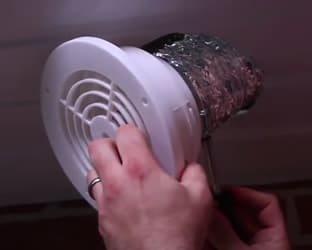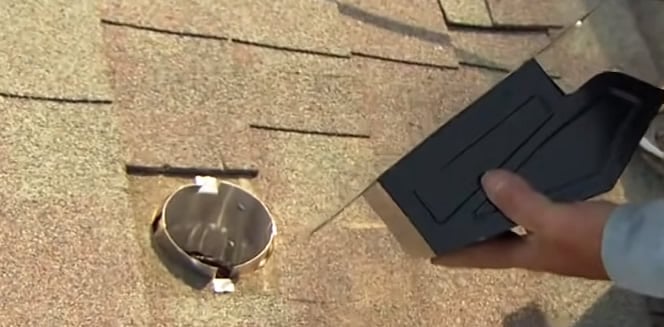So you want to know how to vent a bathroom fan through the soffit? In that case, you have come to the right place.
A bathroom fan is usually vented on the sidewall or to the roof. But in some cases, you may feel the need to vent it to the soffit. That’s because it is not always a good idea to drill a hole through the sidewall or the roof.

To clear out any confusion, the soffit is the underside area of the roof overhang or eave. It is possible to vent your bathroom fan through the soffit and avoid making a hole in the roof.
Usually, a hole in the roof may lead to leaks and other problems. Sometimes it can be difficult to vent a second-story bathroom to the sidewall.
In such cases, venting the bathroom fan through the soffit is probably the best thing to do. If you are interested to know how to vent a bathroom fan through the soffit, you should give this article a read.
I have included all the important things related to the topic including how to install the soffit exhaust vent.
Read also: Bathroom Exhaust Fan With Humidity Sensor
Benefits Of Venting Bathroom Fan To Soffit
Venting a bathroom fan to the soffit has its advantages. Before moving on to any further details, let’s talk about the benefits you will get.
Shortest Duct Length
When you vent a bathroom fan hose duct through the soffit, it will usually take the shortest distance. It is bent flat on your attic and out of the underside of the roof. It could be even better if the bathroom fan is located as close to the wall.
No Back-Drafting
Backing drafting is a problem when a vent runs through the wall instead of the soffit. Since the wind mostly moves horizontally, it blows back into the vent on the side of the house. As a result, your fan is overworked.
Also, it can suck back all the air into the room that you are trying to get rid of. But this kind of problem doesn’t arise when you vent a bathroom fan through the soffit.
Preserved Roof Integrity
Venting the bathroom through the soffit means you don’t have to put a hole in the roof. That’s because it may cause it to leak, especially if you have an old roof or the ventilation is done poorly. Venting the bathroom fan to the soffit helps keep it leakage-free.
Room Heat Preservation
The hose ducts blowing warm, humid air out through the soffit often lie in a horizontal position. When the bathroom fan is in rest mode, this air remains suspended in the duct as there is no fan to propel it out.
This in turn creates a pocket of humid air, which acts as a heat trap and prevents the outside cold air from flowing into the bathroom. This can be a great way to keep your bathroom warm, especially during the winter.
How to install the Soffit Exhaust Vent?
In this section, I will tell you about the soffit vent installation. If you are planning to do install it yourself, you should pay attention to the details given below.
Here is what you need to do:

Don’t bend the hose
When installing the soffit exhaust vent cover make sure not to bend it. Fewer bends in the soffit exhaust allow for better airflow.
But bending in the vent hose can cause water to accumulate in the lower parts due to condensation.
Choose the right vent hose size
To install a new duct for venting your bathroom exhaust to the soffit, you should first measure the duct size of your bathroom fan.
If your bathroom fan is a high-powered one, it may have a large duct size like 4” or 6”. Many old bathroom fans have duct sizes as small as 3”.
Make the soffit hole
You need to install the soffit exhaust vent in the right location and then mark the area of the soffit where you want to draw the hole.
Use a tin snip or jigsaw to cut out the soffit along the hole you marked. Then place the vent hose in the hole you made in the soffit.
Connect the hose to the cover
Pull out the vent hose through the cut hole and then use a metal clamp to connect the vent to the soffit cover. Mount the vent cover to the soffit using screws.
Get the right type of vent hose
You should choose the right size vent hose for your bathroom fan. If needed, ask your bathroom fan manufacturer to find out the right size. Usually, modern bathroom fans require a 4” to 6” duct hose. However, it is always better to confirm once.
Soffit Exhaust Vent Cover
A soffit exhaust vent cover does the same thing as a vertical wall-mounted vent cover. They are highly useful in keeping out moisture, exterior air, and even birds.
If you are bothered by bird nests in the vent, then you need a soffit vent cover is the right solution for you.
What is a soffit exhaust vent?
The question that brought us here is what is a soffit exhaust vent? Before moving on to further details, let’s get to know a little more about a soffit exhaust vent.
A soffit vent is a roof ventilation device that is installed underneath the eave of a roof that extends past the warm wall line. When paired with other roof ventilation systems, it allows fresh air to enter the attic to promote proper airflow.
When it is not feasible to install a bathroom fan into the sidewall or the roof, it is vented to the soffit. Putting a hole in the roof can cause leaking. To avoid this from happening, the bathroom fan is installed on the soffit.
For a second-story bathroom, it may take a lot of work to vent a bathroom fan to the sidewall. In such situations, installing the bathroom fan on the soffit is the best solution. That’s because you have easy access to the attic.
The soffit vent for the bathroom fan can be a bit complex to install. If you are not sure of the steps, it is better to hire a contractor to get the job done.
Bathroom Vent Soffit Vs Roof

If you are confused between venting a bathroom fan to the roof or the soffit, you should pay more attention to this section. I am going to draw a comparison between the bathroom vent soffit and vs roof.
A bathroom fan is vented through a soffit when it is not feasible to vent it to the roof. Both ways of venting have certain advantages and disadvantages. To come to a decision, you might want to take a look at the comparison below.
Soffit
- It is very easy to install the vent.
- It has lower chances of getting blocked due to snow in extremely cold areas.
- Soffits are designed for intake, so there’s a chance that the air will be sucked back into the attic.
- It can lead to the accumulation of moist air under the soffit.
Roof
- It increases moisture and heat.
- It keeps moisture away from windows, walls, and siding.
- It can easily get blocked with heavy snow.
- A roof vent is more difficult to install.
Is venting a bathroom exhaust fan to the soffit bad idea?
So many of you want to know if it is a bad idea to install a bathroom exhaust fan to the soffit vent. Let’s find that out.
Soffits are designed to promote circulation through the attic. But a poorly ventilated attic can become moist with increasing temperatures. This in turn can cause damage to rafters, shingles, and existing venting.
Whereas in cold and damp weather, excessive moisture can lead to mold growth and even cause rotting. This is why a soffit paired with roof vents should be able to provide sufficient airflow.
Now, what about the warm moist air coming back into the attic through the soffit? This is one major concern that needs to be addressed.
If the ends of the duct connecting to either the soffit or bathroom fan are not sealed properly, moist air can come back into the attic. This increases the risk of mold growth in the attic.
But when both the duct and the bathroom fan leading out to the soffit are well insulated and secured, there will be no problem with any warm air accumulating in the attic.
Roof venting is often used as an alternative to the bathroom exhaust soffit vent. The challenges for soffit installations can be solved with a vent that bends out from the building.
You can also install grilles to block entrance to dampers and critters and thus, prevent the cold air from returning back from outside.
Hopefully, this should answer whether you should go for a bathroom exhaust soffit vent or not.
Venting Bath Fan Through Soffit: What is the best way?
Venting the bath fan through the soffit may sound intimidating if you are doing it for the first time. But you are always free to take help from online tutorials.
You will find several guides on how to vent the bath fan the best way.
You should also follow the bath fan soffit vent installation instructions given by professionals. This will help you understand what to do and how to do it.
You are also recommended to get a quality fan that comes with one-piece insulated flexible piping to avoid leaks. If you are determined to vent a bathroom fan on your own, then make sure you do it right.
Q&A
Does the bathroom fan have to vent outside?
Bathroom vent fans must be vented outside as venting it into the attic will invite problems. Excessive moisture will lead to condensation on the roof and eventually cause mold growth. This is why you should never vent directly into an attic even if your attic is itself vented.
How do you vent a bathroom fan in a cold climate?
You should never allow a bathroom fan to exhaust into the attic space. It is often recommended in cold climates that bathroom fans should be vented down through the wall and out by the edge of a foundation. This method reduces the chances of interior moisture drip.
How far can you run a bathroom fan vent?
Generally, a 4-inch flex duct can carry a bathroom fan exhaust for up to 25 ft. That is required by most codes.
Should I use an insulated duct for the bathroom fan?
You should insulate the bathroom exhaust vent fan ducts in the attic and use an insulated flex duct or solid metal ducting. However, it is not recommended to purchase vent ducts with insulation on the duct interior.
Conclusion
People often vent a bathroom fan through the soffit when it is not feasible to vent it to the sidewall or the roof.
Installing a bathroom exhaust fan to the soffit can be completed within an hour or two provided you have all of the right tools. The ease of installation with attic access is a major advantage to installing a bathroom fan in the soffit.
